Although their main purpose is protection, rug pads for soundproofing can also help reduce sound transmission within a room. So, if you’ve got downstairs neighbors or want to improve sound quality in a space, a soundproof rug pad could be a good addition.
In this article, I’ll cover my top picks for the best rug pads for noise reduction. Before we jump into the reviews, let’s recap some useful information regarding sound types and metrics.
Do Soundproof Rug Pads Help with Noise?
Soundproof rug pads can help with sound transmission and, to a lesser extent, reverberation within a room. Of course, they won’t offer the same kinds of benefits as carpets and carpet pads, as they don’t cover the whole floor. Rug pads can offer some reduction of sound nonetheless.
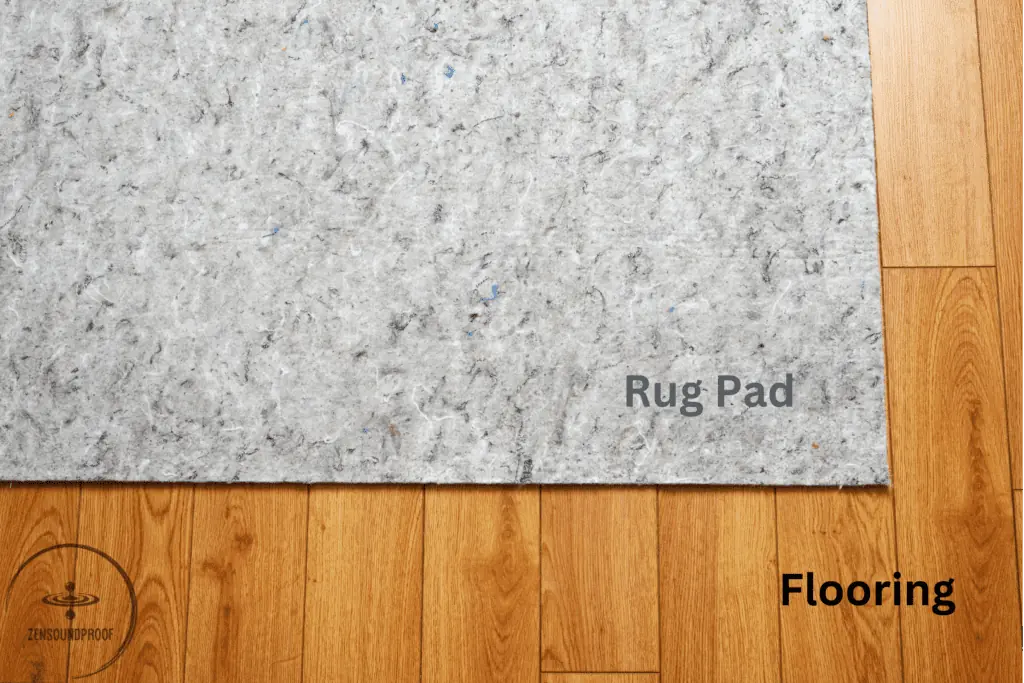
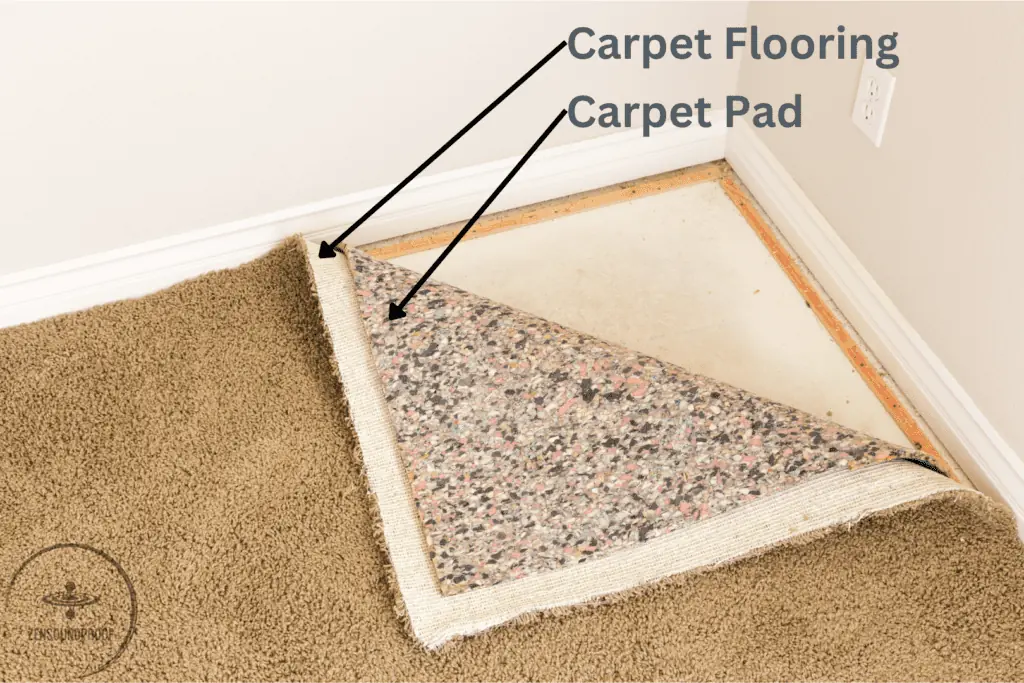
To understand this, we should recap the types of noise we’ll be dealing with.
Types of Noise
Sound waves are vibrations, whether traveling through the air or an object. Within the overall subject of noise, we have 2 types: impact and airborne.
Airborne noise is, unsurprisingly, sound that travels through the air. It leaves the source and reaches your ear without passing through any objects. Some examples include TV sound, music, and people talking.
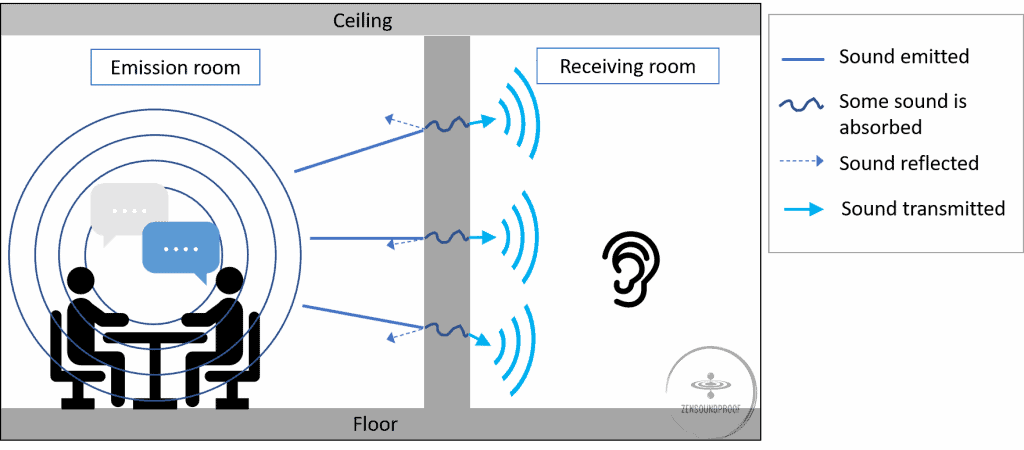
Impact noise is sound that travels through a structure before reaching your ears. Typically, it’s sound caused by an object impacting a surface, such as footsteps or a ball bouncing on a floor.

When looking at the best rug pads for soundproofing, we’ll mainly deal with impact noises. A rug pad is most effective against impact sounds because it adds another layer of cushioning to the floor. However, they can also help with sound absorption to a lesser extent.
Measuring Impact Noise Insulation
To measure a material’s ability to reduce impact sounds, we use a metric called Impact Insulation Class (IIC). Materials are tested in a lab using standardized equipment that measures how well the product reduces audible impact sounds passing through a structure.
Unfortunately, most rug pads won’t come with an IIC rating. This is because, unlike carpet underlayment, pads are not meant to cover the whole floor. As such, it’s impossible to predict each user’s coverage area and thus how much they reduce impact sound transmission through a structure.
I have a separate article on soundproof carpet pads, which I recommend you check out if you’d like to understand more about IIC ratings and how it helps with soundproofing.
We also use a metric called Sound Transmission Class (STC). It’s designed to measure airborne sound transmission rather than impact sound. Again, it’s not too relevant here because rug pads won’t add much mass or surface coverage.
Measuring Sound Absorption
While IIC measures impact sound, another metric worth discussing is NRC. It stands for Noise Reduction Coefficient, and is used to measure a material’s ability to absorb airborne sounds. As I discuss in my carpet underlay article, adding a soft (and ideally dense) material under carpet can improve its NRC rating.
To give you an idea, tests done by the Carpet and Rug Institute suggest that adding padding under a carpet can increase its NRC value by 0.1 up to 0.2. This is not loads, especially considering that absorptive materials like fiberglass and Rockwool have an NRC of around 0.7-0.9.
However, even a small amount of absorption is useful because it decreases the area off which sound waves can reflect. So, a rug with a pad underneath will be more effective at absorbing sound waves than a bare hard floor.
Using Sound Decoupling
Decoupling is one of the 4 main principles of soundproofing. In short, it involves separating a noise source from a structure with a resilient material (like a rug pad)..
The aim is to prevent the soundwaves from propagating into the structure. At the impact point, the sound waves will dissipate into the resilient material instead of traveling straight into the floor structure.
In the case of a rug pad when soundproofing floors, it’s about adding a layer of separation between the noise source and the surface (in this case, the floor).
We’ll be using decoupling to an extent below. With the right product, we can achieve a level of sound decoupling between the rug and the floor. It’ll be difficult to have sound decoupling metrics as most suppliers don’t specify an IIC rating for rug pads. However, increasing the factors results in a positive correlation with decoupling effectiveness.
What Affects Decoupling
There are 4 properties that affect a rug pad’s decoupling ability:
- Type of Material: Decoupling materials ideally should dampen vibrations to reduce transmission. Examples include rubber and felted fibers.
- Resiliency: A resilient material has viscoelastic or elastic properties. This means they vibrate but don’t pass on the vibrations. Instead, they return to their original position.
- Weight: Although resilient materials are generally considered lightweight, the heavier a rug pad, the better its impact insulation. The Carpet and Rug Institute (CRI) conducted some tests, which concluded that a higher density helped increase the IIC rating.
- Thickness: The thicker the material, the further the soundwaves need to travel within the pad. As a result, more sound waves dissipate.
In my reviews below, I’ll focus on these properties more than IIC ratings. They’re more readily available and there’s fairly clear logic to follow when choosing the right products.
3 Best Rug Pads for Soundproofing
So, let’s dive into the reviews for the best rug pads for soundproofing. Remember, unlike carpet underlay, rug pads are harder to quantify in terms of sound reduction properties. Even so, we can find some worthwhile products.
1. Top Pick: RUG PAD USA Superior Lock Protective Rug Pad

With the option of 0.25” or 0.44″ thickness, the Superior-Lock from RUG PAD USA is a great balance of sound decoupling, non-slip and price. While it doesn’t have the same kind of rebound as memory foam, it’ll still provide decent cushioning underfoot.
It’s my top pick despite being felted fiber. While this is one of the less effective materials for rug and carpet pads, the Superior Lock pad has the best weight density of the other options reviewed below (31.5 lbs for a 9’x12′ pad). Weight and thickness are major factors when it comes to sound decoupling and absorption. As such, the 0.44″ thick option will perform better.
Felt helps absorption and decoupling, making it a decent option for all floors and rooms. The Superior Lock pad is a relatively pricey option, but you get decent weight, thickness and density for the price.
RUG PAD USA also does a Basics Rug Pad, which is less than half the price. However, it’s also less than half the weight, so won’t provide as good performance as the Superior Lock. That said, it’s still my budget pick because it’s noticeably cheaper than the other options.
| Model | Size | Thickness | Weight | Price |
|---|---|---|---|---|
| RUG PAD USA: Superior-Lock | 9’x 12’ | 0.25” | 31.5 lbs | |
| RUG PAD USA: Basics | 9’x 12’ | 0.25” | 14.8 lbs |
Unlike the foam options below, it doesn’t have a rubber back. This means it’s suitable for all kinds of flooring, as it won’t leave marks. Rubber can react with vinyl flooring, causing stains. Unsurprisingly, though, this means it doesn’t provide any grip, so you’ll need to combine it with another product.
Check out the video below for the summary of the key features of the Superior-Lock rug pag.
Other than this, some users state their rug pads weren’t the correct size. Luckily, most were bigger, and the felt is easy to cut with scissors. It’s therefore not a massive issue but is worth mentioning in case you need to adjust the size you buy.
- Decent thickness adds cushioning.
- No rubber means it’s suitable for all floor types.
- Felt will add some sound muffling.
- Lack of rubber means it won’t provide much grip.
- Sizes don’t seem to always be accurate.
2. Top Pick for Cushioning: Carpenter Memory Foam Rug Pad

As the name suggests, the Carpenter Rug Pad is made from memory foam. Importantly, it’s a viscoelastic material, which is helpful for decoupling. And, at 0.5” thick, it’s about as thick as you’ll get for a rug pad.
| Model | Size | Thickness | Weight | Price |
|---|---|---|---|---|
| Carpenter: Memory Foam | 9’x 12’ | 0.5” | 28 lbs |
The memory foam functions just like the foam on a mattress: it compresses and then returns to its original position. For reducing impact sounds, this is ideal, because it effectively “absorbs” structure-borne soundwaves from footsteps.
The product’s weight is slightly less than the Superior Lock pad above. It’s 28lbs for a 9×12 pad rather than 31.5lbs. Even so, it’s heavy enough that it’ll provide a decent level of decoupling and absorption when placed under a rug.
Plenty of users comment that it feels very comfortable underfoot too. If you’ve ever slept on memory foam, you’ll know what it’ll feel like. Provided you can accommodate the thickness, it’s an ideal product for cushioning a rug.
It also includes a waterproof barrier for protecting floors. However, its major downside is that there’s no rubber backing. You can still use it on hard floors, but you’ll need to add a carpet gripper or two (such as this). For the price, it’s a bit annoying that you need another product, but it’s potentially worth it for the level of decoupling it provides.
- Thick, viscoelastic memory foam.
- Ideal for added comfort and decoupling.
- Includes waterproofing protection.
- Not suitable for keeping rugs in place – an extra gripper is required.
3. Gorilla Grip Rug Pad

The Gorilla Grip Felt and Rubber Pad is my top pick for decoupling. Whereas the memory foam pad will provide excellent cushioning, the Gorilla Grip pad is the only one made from explicitly resilient materials.
At 0.25” thick, it’s relatively thick and is fairly dense. It combines a felt upper with a rubber backing, which is its resilient material. Its thickest option is 0.25”, which is why it missed out on the top spot. If it came in the same maximum thickness as the Superior Lock, this would’ve been the runaway winner.
| Model | Size | Thickness | Weight | Price |
|---|---|---|---|---|
| Gorilla Grip: Felt & Natural Rubber | 9’x 12’ | 0.25” | 24.6 lbs |
Most of its bulk comes from felted fibers. While this is one of the less effective products for decoupling, adding a layer of rubber on the bottom does improve it. Also, the fibers are dense, meaning they won’t be crushed through use. You could find this happens with a thicker rubber-only product.
Importantly, the rubber backing provides grip, and the felted fibers will help protect your rug. It’s natural rubber backing, too, meaning there should be minimal off-gassing compared to synthetic products. Although it’s available in plenty of sizes, users state it’s easy to cut to size too.
Some users state that their rugs slide off the Gorilla Grip rug pad. This seems to be the case if the rug has a more slippery backing. While not ideal, you can solve this using some rug grippers (such as these).
- Combines felt and rubber.
- Fairly thick and dense – at least for a rug pad.
- Available in numerous sizes and can be cut easily.
- Rug grip is average.
What Else to Consider in a Soundproof Rug Pad
Other than material and thickness, there are some important factors to consider when choosing a suitable rug pad. Here’s what else to keep in mind.
Grip
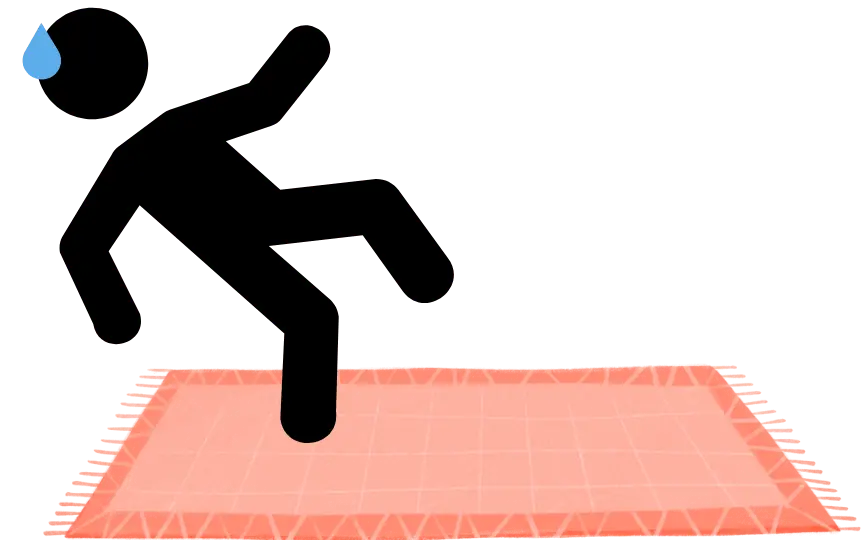
For hard flooring, a non-slip rug pad is a no-brainer. Rubberized backing helps stop the rug pad and rug from slipping around on hardwood floors, which can lead to bunching or tripping.
It’s less important on carpeted floors but can still be useful, as it prevents the rug from migrating. If your chosen rug pad doesn’t have rubber backing, you’ll need to add a separate gripper layer.
Grip either comes as a full rubber backing or textured checker rubber backing. The full rubber layer is better for decoupling and grip, so go with that if you can. Latex backing is another option, but it smells more than natural rubber. Both are equally slip-resistant, though.
However, bear in mind that rubber products can react with vinyl flooring. In these cases, you’ll want to use tape instead, as it’s less likely to damage the floor.
Cushioning

Cushioning is typically a side-effect of sound decoupling and noise reduction. This is because the products we use are often soft and/or thick, which adds cushioning.
While not necessary, cushioning gives you a more comfortable walking surface. Similarly, it can be a helpful addition if kids play on the rug (especially if you’re sitting there with them!).
Felted rug pads provide suitable cushioning, but memory foam is arguably the best product. However, it compresses more than felt, meaning the latter is a good compromise between comfort and resilience.
Floor Protection
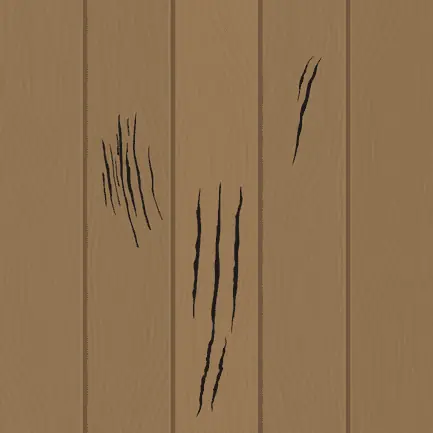
Rug pads help protect your floor from dents and scuffs. But some pads include waterproof protection to also prevent stains and other marks.
Again, it’s not a necessity but is worth considering if your floor is old, expensive, or untreated (such as bare wood or tiles). However, it’s helpful for all kinds of wood floors, including laminate flooring. After all, more protection is never a bad thing.
The only rug pad on this list with explicit waterproofing is the Carpenter Memory Foam Rug Pad. However, rubber-backed pads will provide some waterproofing, provided it’s a complete layer of rubber. While it might not completely stop liquid, it’ll at least delay it enough for you to pick the pad up.
Rug Protection
The primary purpose of rug pads is to protect the rug itself. Adding a pad makes vacuuming easier and reduces wear from friction between the rug and floor. A quality rug pad can drastically improve the lifespan of a rug.
As such, I wouldn’t recommend going any thinner than 0.25”. This is also a good minimum for sound reduction, as anything below will be too thin to do anything worthwhile.
Felt products are good for friction resistance and making vacuuming easier. They provide better airflow under the rug, meaning it’s easier to suck up debris. This also helps to reduce musty smells.
Size and Installation
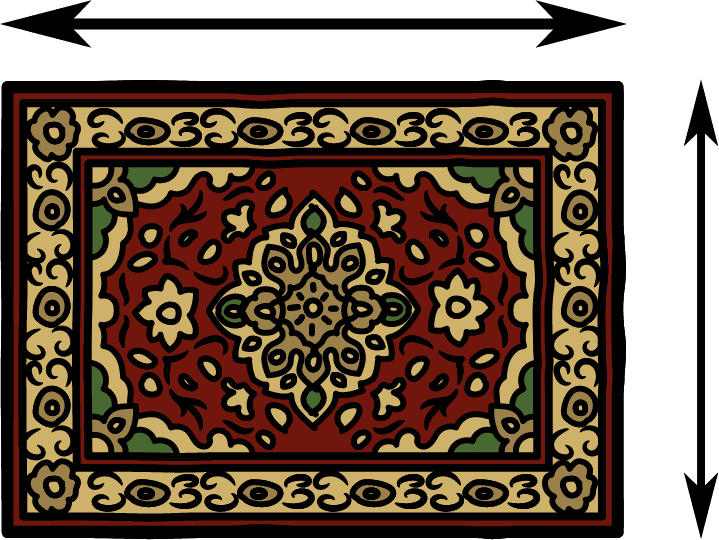
Most rug pads come in a wide range of sizes to fit anything from area rugs to runners. Generally, it shouldn’t be difficult to find your chosen rug pad in the correct size, although you might have to compromise on thickness depending on the product.
Alternatively, you could try contacting the supplier to see if they’ll do a custom size. You could also cut the rug pad to size yourself depending on the material and thickness. Something like felt is pretty easy to cut with scissors, although you might struggle to cut thick memory foam.
There’s not much to say about installation. Most rug pads will need off-gassing (airing), as they can often smell of chemicals. The actual installation, though, boils down to rolling it out and then laying the rug on top!
Final Thoughts
I hope this article has given you some useful information on the best rug pad for noise reduction.
My top pick overall is the Superior-Lock by RugPadUSA. It combines an appropriate thickness with resilient materials to provide a decent level of decoupling and sound resistance.
Of course, the other products I’ve reviewed will be suitable alternatives depending on the thickness you need and your budget.
Do you have another rug pad that you recommend for sound reduction? Let me know below!
